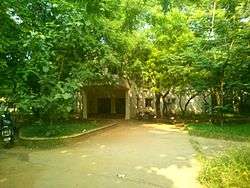Anna University K B Chandrashekar Research Centre
The Anna University - K. B. Chandrashekar Research Centre (AU-KBC) is a multi disciplinary training centre located in the Madras Institute of Technology (MIT). The centre was founded by volunteer K. B. Chandrashekar, MIT alumnus and co-founder of Great Lakes Institute of Management, Chennai. The AU-KBC Research Centre is a first of its kind, a public-private research centre in India, being the partnership between a wholly for-profit company (KBC Research Foundation Private Limited, KBCRF[1]) and a state institution (Anna University). The Center has no employees, and all researchers stationed there are employees of the for-profit company KBCRF.[2] The Centre's original goal, when it had its own employees, was to generate research and products of international quality. Its current goal is to create revenue for KBCRF and its sister for-profit concerns.
 | |
| Abbreviation | AU-KBC Research Centre |
|---|---|
| Formation | 1999 |
| Type | Public Private Partnership |
| Headquarters | Chennai, India |
| Location | |
Director | Dr. Gautam Pennathur |
Parent organization | Anna University |
| Website | au-kbc.org |
Mission and goals
The AU-KBC Research Centre initiates research in new and emerging thrust areas such as nanosciences and expands research in established areas such as communications and biology with a strong modelling and experimental component. There is a strong interdisciplinary core of mathematics, physics and computing sciences that impact on all the teaching and research work at the Centre. The Centre does academic research with a prominent long-term perspective; the choice of directions and problems however are made in close interaction with industry. Research in core and thrust areas are oriented towards practical applications and also serve as a source of skilled personnel in niche areas.
Focus areas of the centre
The major areas in which the centre dabbles are information sciences, Life sciences, mathematics, physics, bioinformatics, nanobiology, cryptography, network security, communications engineering and natural language processing.
The centre is also concentrating on producing individuals in the field of clinical research. Clinical research in India has the fundamental merits of sparse federal oversight, and a drug-unexposed population. Accordingly, the centre has started a course "Post Graduate Certificate Program in Clinical Trials Management". The clinical trials course at the centre offers its trainees a headstart with multinationals who wish to use these unprecedented opportunities for drug trials (Phase II) in India. It is offered both full-time and part-time and is a first such course offered by a public-private institution.
Achievements
Employees of KBCRF stationed at the AU-KBC centre have the "rare" opportunity of receiving taxpayer rupees from various national (government) and international research institutions, even while "enjoying" all the "benefits" of being employees of a purely for-profit company. The centre has generated papers in all the fields and has its material published in major journals and conferences. The centre also acquired its first patent in the communications engineering area. The Government of India has funded the Centre to push the open source activities into the regular academics and to contribute in Free and Open Source Software (FOSS) mission for future generations. To coordinate these activities, the centre in collaboration with the Chennai Division of the Centre for Development of Advanced Computing (C-DAC), has set up the National Resource Centre for Free/Open Source Software.
Educational opportunities
The M.S. (By Research) and PhD Programs of the Anna University in all the areas of Information Sciences and Life Sciences are offered at the AU-KBC Research Centre as per the rules and regulations of Anna University.
References
- KBC Research Foundation, "KBCRF" Archived 22 April 2009 at the Wayback Machine
- KBCRF "KBCRF researchers at AU-KBC" Archived 29 April 2009 at the Wayback Machine